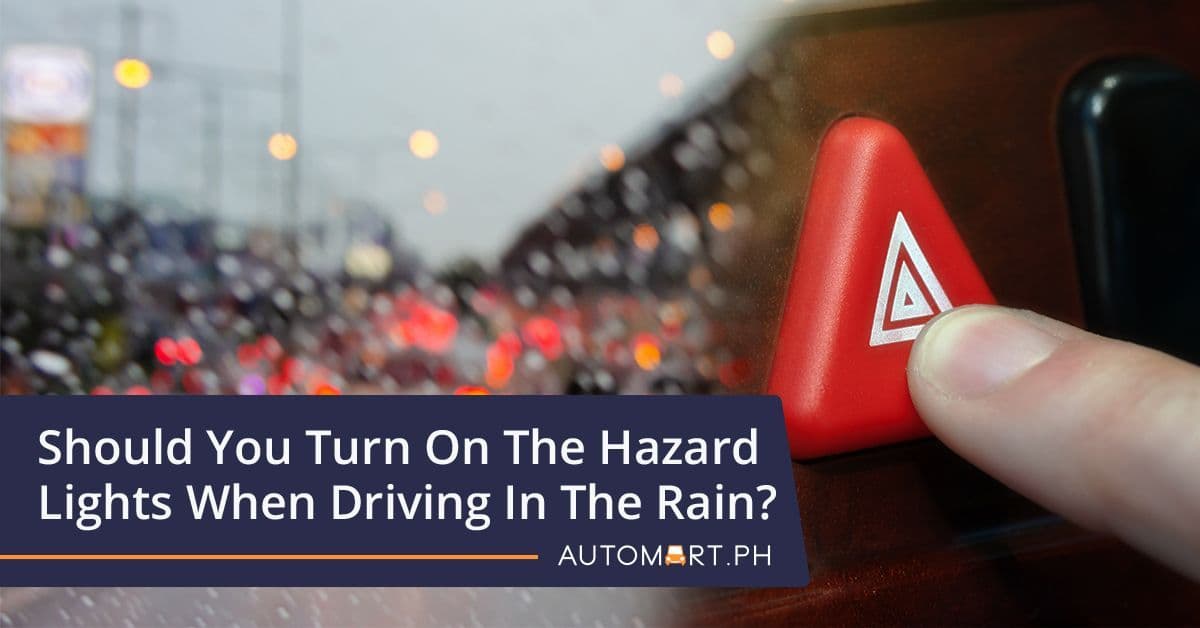
Should The Hazard Lights be on When Driving In The Rain?
Updated on December 18 2025
It’s a common sight on Philippine roads during a heavy downpour. Filipino drivers have a penchant for turning on the hazard warning lights when driving in the rain, but this should not be the case.

Most drivers think turning on the hazard lights increases their car’s visibility to other motorists when the weather gets dicey. However, it’s the opposite of what the law states on when to activate the hazard lights.
When should I use the hazard lights in my car?
Before you fight for your right to engage the hazard lights in the rain, it’s essential to understand why the hazard flashers are there in the first place.
The Philippines was an official participant in the 1968 Vienna Convention on Road Traffic. In Article 32, section 13 on the “Rules of the use of lamps,” the international treaty laid down instances on the proper use of vehicle hazard lights, warning flashers, or emergency lights:
The hazard warning signal may be used only to warn other road users of a particular danger:
- When the vehicle which has broken down or has been involved in an accident cannot be moved immediately, so that it constitutes an obstacle to other road-users; and
- When indicating to other road users the risk of an imminent danger.
In a nutshell, the hazard lights are for stalled vehicles on the road – meaning, if your car breaks down, has a flat tire, if the car won’t start. You can also engage the emergency flashers if you were involved in an accident wherein your vehicle has become an obstruction on the road.

The treaty never said anything about engaging the hazard lights when driving in the rain. But despite this, hard-headed Filipinos insist on using the hazard flashers for a bewildering array of reasons, like when parking illegally on the side of a busy road network.
There are exemptions to every rule. The Vienna Convention allows slow-moving vehicle convoys to engage the hazard lights even if the cars are in motion, like in a funeral procession. But generally speaking, the hazard flashers should be OFF if your vehicle is moving.
Should I turn on my hazard lights when driving in the rain?
No. If you think turning ON the hazard flashers while driving in inclement weather increases your car’s visibility to other motorists, you are sorely mistaken. On the contrary, the hazard lights will make your vehicle less noticeable.

Motorists may think your vehicle has stopped or stalled, and other drivers may swerve out of the way to avoid your car, which could potentially lead to more accidents.
In addition, blinking hazard lights makes it difficult to see the rear tail lights when stepping on the brakes. Making things worse is the inability to use your turn signals if the hazard lights are ON.
What should I do when driving in poor visibility?
Instead of turning ON the hazard warning flashers, you can do the following things when driving under heavy rain or fog:

- Turn ON the headlights.
- You can also turn ON the fog lights.
- Reduce your speed.
- Maintain a safe distance to the vehicle ahead, preferably three-car lengths if visibility is poor.
- Do NOT engage the high beams so as not to blind oncoming traffic.
- Reduce the music volume to create better awareness of your surroundings.
Conclusion
In 1973, President Ferdinand Marcos ratified the 1968 Vienna Convention on Road Traffic and made it part of the “law of the land.” If you insist on turning ON the hazard flashers for any reason besides an emergency, take comfort in the fact that you are breaking the law while doing so.